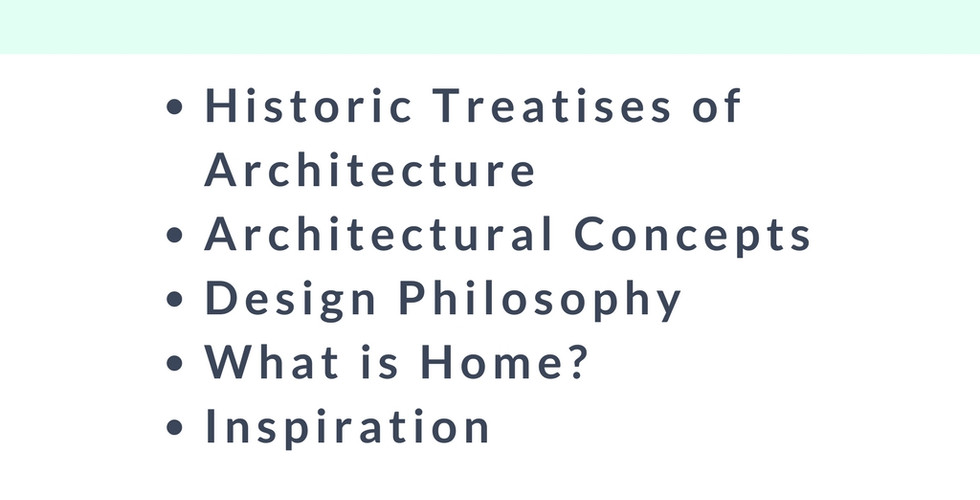My Ideal Home: Architecture and Sculpture for grade 11
- Natassja King

- Mar 5, 2017
- 5 min read

Time Frame
8 classes of 75 minutes each
Rationale
Students will become familiar with the historic treatises of architecture, basic architectural drawing concepts, and model-building skills via this multi-disciplinary visual arts project. In doing so, students will also explore the differences between "wants" and "needs," personal aesthetic preferences, and practicality in architecture. Students will present their final artworks, and will identify how their research impacted their creative process. Students will explain the connections between their final pieces and the stimulus for creation.
Materials
18"x24" grid paper
Computer access
Internet access
18"x24" foam board
Recycled materials, including paper, cardstock, plastic, wire, and more
Glue (white and hot)
Tape (scotch and masking)
Paint (acrylic is best)
Pens, pencils, and rulers
Lesson Sequence Overview
In the first class, the students will learn about the Historic Treatises of Architecture and other basic architectural concepts with the help of a PowerPoint presentation (below). Using PowerPoint (if available) or Canva.com (a free web-based digital editing program), students will compose an Inspiration board collage. The board will contain at least 15 images, and must include at least one example of a floor plan, an exterior shot, an interior room shot, texture, pattern, and a colour palette. Students will also complete a reflection describing and explaining their choices, and explaining how they intend to build on the ideas in their inspiration boards.
In the second and third classes, the students will be given an 18"x24" drafting sheet to use in the creation of their ideal home's floor plan. Students will have two class periods to finish this complicated step.

In the fourth and fifth classes, students will compose three drawings of their homes, also on drafting paper. Each drawing will demonstrate one-point, two-point, and three-point perspective. It is recommended that students draw a room for one-point perspective, and the exterior for three-point perspective. Two-point perspective can be up to them.
In classes six, seven and eight, students will build their scale models of their homes. They may either complete a full interior of one floor, or a full exterior of all floors. Students must use recycled materials only, and demonstrate creative problem-solving. They may revise their designs somewhat at this point, to accommodate their materials (similar to revisions that happen in real life when faced with budgetary or material constraints).
In the ninth and final class, students will present their final artworks to the rest of the class. They will identify how their research and design philosophy impacted their creative process, and describe the challenges that arose over the course of the project, as well as how they overcame them. The models may be put on display afterwards in the school library, where the librarian can keep an eye on them, or in various glass trophy cabinets around the school.
Vocabulary
The Historic Treatises of Architecture
A treatise is another name for a basic principle or foundational idea. The historic treatises of architecture are three basic ideas about architecture: Durability (it should last a long time and not fall over or blow away); Beauty (it should look good to you and fit your tastes); and Utility (only keep the ideas that are useful, for instance if your ideal home is in the Arctic then having an open-air patio is not a good idea).
Architectural Concepts
A concept is an idea or plan, a thought that helps to guide us. So an architectural concept is the designer's unique, personal approach to solving a design problem.
Design Problem
This is your challenge as a designer. In this case, your design problem is that you have just won the lottery. You have no house, and would like to build one. Money is no object, the only limitations are the Treatises we discussed.
Design Philosophy
A design philosophy is the personal approach to design that makes every designer create something different even when they are all presented with the same problem and constraints. You have all been given the same problem but you will all create something unique and different because your design philosophy guides you (whether you know it or not). Some of you value our social circles, which will lead you to leave space for entertaining large groups at parties. Some of you really enjoy gaming, so maybe you will include a deluxe home theatre. Or maybe reading is more your thing, in which case you might choose to have a library at home. Your design philosophy helps you decide between a big impressive house or a mobile tiny home with an equally tiny carbon footprint. Maybe you plan to spend hardly any time at home so you can travel, so it doesn't need to be very heavily decorated or personalized. Or maybe you're a homebody who expects to spend most days indoors, so your home will be a very personal extension of you as a person. All these factors influence the choices you make in your design.
Inspiration Board
This will be our first step in this project. An inspiration board contains several images, colours, textures, patterns, materials, and objects that help you to collect an overall idea of your home before you get into the more specific questions of floor plans and square footage and picking out furniture. Your inspiration board is not law - your images are going to be interpreted into something new. Feel free to include more than one floor plan or picture of a kitchen or backyard - as long as there is one part from the photo that you do want to include eventually.

Scale Model
This is helpful for architects who want to try out their design before building it in real life. They can show it to clients who have commissioned the design to give them a chance to request any changes before it's too late, and the model can be kept afterwards as a keepsake.
One-Point Perspective
A way of indicating three dimensions (height, width, and depth) on a flat two-dimensional surface. All vertical lines are parallel, and so are all horizontal lines, but the third line type (indicating depth) all joins at a single vanishing point - hence, one-point.

Two-Point Perspective
This time, instead of one vanishing point, there are two. The width and depth lines both gather at separate vanishing points on either side of the drawing. They sit on the same horizon line, and the vertical lines (height) remain parallel to each-other.

Three-Point Perspective
This style has no parallel lines. All vertical lines share one vanishing point, width lines share a second vanishing point, and depth lines share the third. The three vanishing points form a triangle, with the drawing itself in the middle. This is the most dynamic of the three styles, and is best suited to drawings of the exterior.




































Comments